
iuniti eitchilívin ín a mâlticâltiurol uôrld


Gêneros discursivos: relato escrito e cena de filme.
Tema: diversidade cultural e mal-entendidos.
Os objetivos desta unidade são:
- familiarizar-se com os gêneros discursivos relato escrito e cena de filme;
- refletir sobre o papel da cultura na interpretação do comportamento das pessoas.
TIME TO THINK
Faça no caderno as questões de resposta escrita.

1.
I.

II.

III.

- Relacionem as imagens às descrições.
- Homens escoceses usando quílts.
- Homens judeus usando quipás.
- Mulheres muçulmanas usando ríjabs.
b. Escolham uma das imagens e pensem: se vocês pudessem pedir às pessoas retratadas mais informações sobre suas roupas, o que perguntariam?

-
- Que tipo de comida você não deve pedir na Índia?
- bíf
- Esse alimento não é consumido por indianos porque eles acreditam que
- galinhas provocam doenças.
- vacas são animais sagrados.
- peixes contêm impurezas.
- porcos simbolizam o nascimento.
- Que tipo de comida você não deve pedir na Índia?

-
- Vocês acreditam que choques culturais acontecem apenas entre pessoas de diferentes países ou também de um mesmo país? Justifiquem sua resposta.
- Quais estratégias vocês adotariam para evitar interpretar erroneamente alguém de outra cultura?
- Na opinião de vocês, quais costumes comuns seriam motivo de estranhamento para um estrangeiro visitando o Brasil?

4.
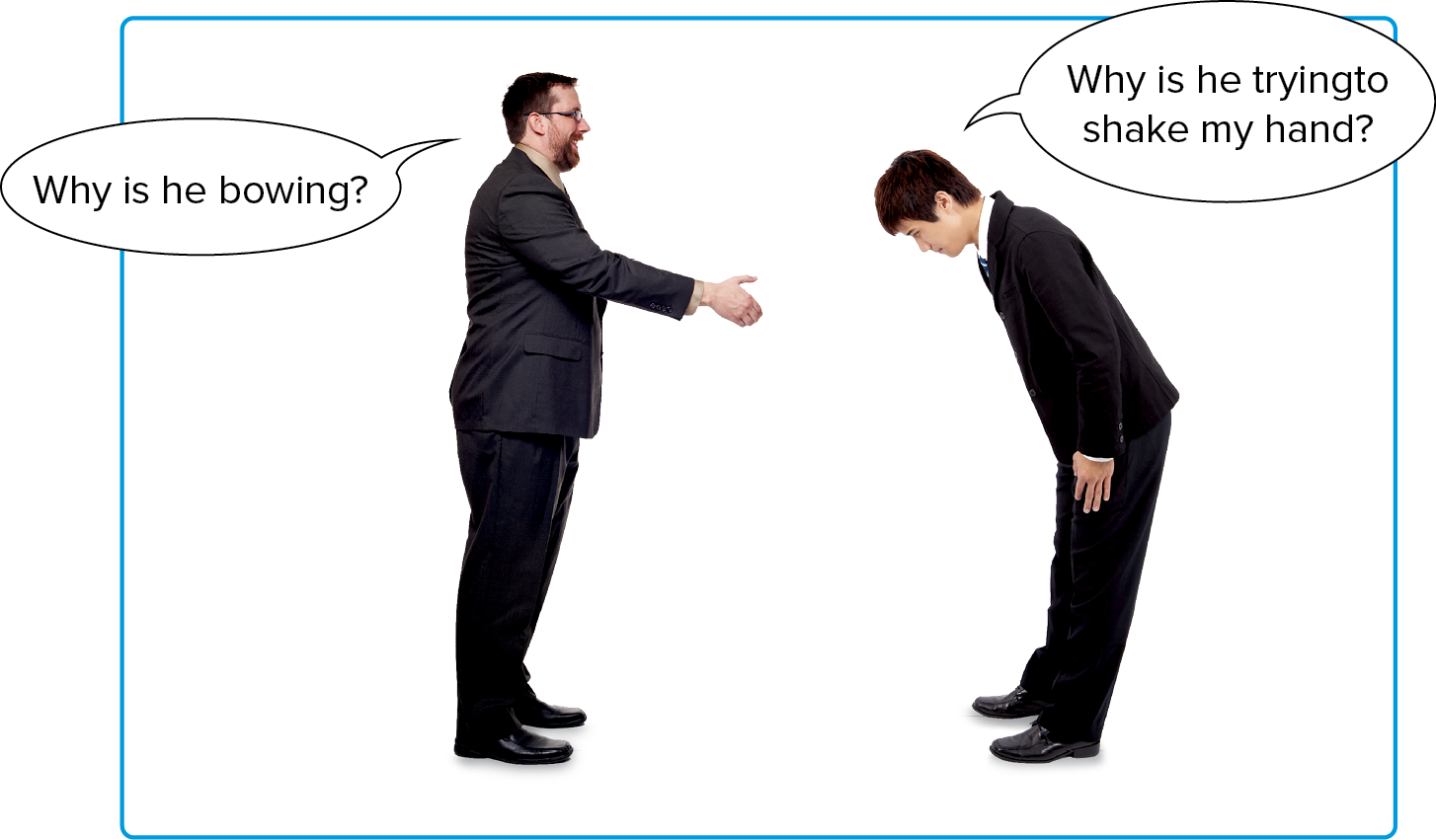
- Qual situação a imagem representa?
b. Na opinião de vocês, por que esse tipo de situação acontece?

5.
mis-un-der-stand-ing
1 a situation in which a comment, an instruction, etc., is not understood correctly.
2 a slight disagreement or argument.
MISUNDERSTANDING. In: HORNBY, A. S. Oxford Advanced Learner’s Dictionary of Current English sétima edição Oxford: Oxford University Press, 2005. página 980.
- Qual das acepções se relaciona com a imagem da questão 4? Por quê?
- Em português, qual palavra vocês acham que corresponde a mizãndersténdin?
- Como vocês definiriam o termo cultural mizãndersténdin?
6. .
Stereotypes are generalized but unfounded ideas and opinions about people, countries, cultures, etc.
- Com base na definição, escolham três palavras que, na opinião de vocês, podem motivar estereótipos com relação ao Brasil.
- Futebol
- Carnaval
- Gastronomia
- Praia
- Música
- Natureza
b. Verifiquem com os colegas quais foram as três palavras mais escolhidas e discutam as razões para essas escolhas.
rídin
Faça no caderno as questões de resposta escrita.
Task 1
Before reading


- ríd tchu lârn
-
ríd tchu lârn

Eyes on grammar – EXAMPLES 1 AND 2
![Reprodução de navegador da internet com três bolas nas cores vermelho, amarelo e verde no canto superior esquerdo sobre barra cinza. Texto: How I Offended an Entire Class through Cultural Ignorance March 22, 2010 by Lillie Marshall ‘We would like to present you with a gift,’ said Madam Yvonne breathlessly over the phone, 'to say thank you for teaching in our school […] these past three months! Please stop by our school anytime today.' 'Sounds great!' I said. So […], Oliver […] and I hopped on our creaky bikes to the far-off school. We arrived! The students were in the middle of Culture class […]. 'Madam Lillie,' Yvonne said ceremoniously, picking up a sparkling red and silver wrapped package, 'we appreciate all the work you have done with us and we would like to present you with this gift to say thanks.' Amazing! I was overjoyed and so touched! 'Shall I open it right now?' I asked dramatically, trying to build suspense and excitement for the unveiling, as we do so often back in America. 'No!' said some of the students. 'Yes!' said others. Hmm… that was odd. 'Am I supposed to open it in front of them?' I whispered desperately to Oliver, realizing I was entering a cultural confusion castle. Oliver made some gesture with his head that was somewhere between a 'No' and a 'Yes.' I was awfully confused. […] Well, at this point it would have been very rude in America not to proceed with the unwrapping. […] In my country, when we put in such an effort, we look forward to seeing the look on the recipient’s face when they hungrily rip it open in front of us. How could I let them down?](../resources/images/im_156_173_bw8_u08_f2_g24_group_496427_1.png)

MARSHALL, L. How I Offended an Entire Class Through Cultural Ignorance. Around The World: with teacher-traveler Lillie. Boston, Estados Unidos da América, 22 março 2010. Disponível em: https://oeds.link/M8rYjx. Acesso em: 30 abril2022.
constrãquitchion minins

-
- (bifór rídin) ?
-
- óstrêilia
- sáufi éfrica
- iunáited istêits

-
- .

-
-
- .
- .
- .
-
tésqui tchu
bifór rídin

- tesqui uon rídin

-
- .
- .
- .
3.
I.
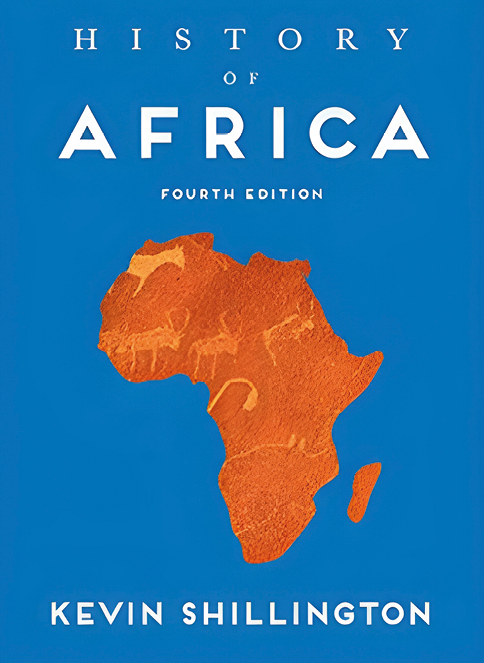
II.
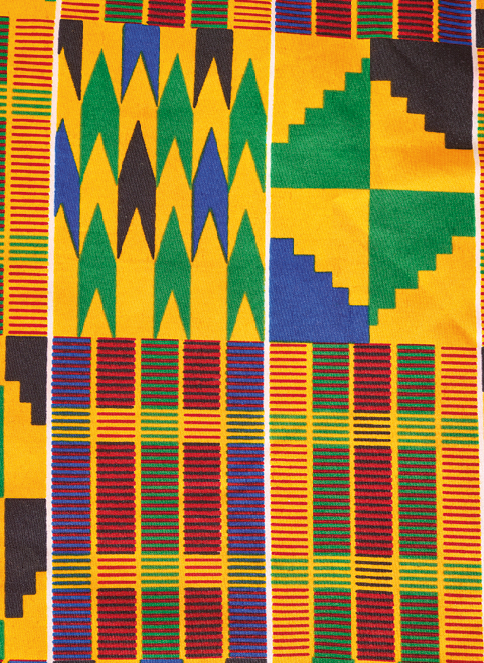
III.
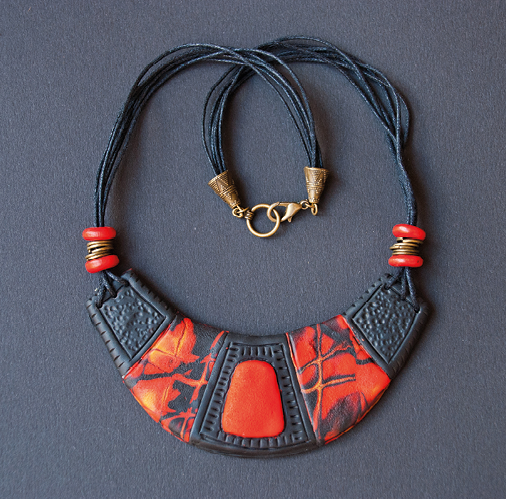
ríd tchu lârn

Eyes on grammar – EXAMPLES 1 AND 2
![Reprodução de navegador da internet com três bolas nas cores vermelho, amarelo e verde no canto superior esquerdo sobre barra cinza. Texto: "Four layers of wrapping paper later, the most beautiful kente pattern fabric imaginable unfurled itself into my hands. Gold! Purple! Yellow! Green! Oh, the beauty! 'This is as if you took all my most precious dreams and put them in the form of a cloth,' I gushed, choking back tears of emotion. 'It is the most perfect gift ever. Thank you so much!' I handed my camera to Oliver to take photos […]. Again, I noted some strange expressions on the faces of everyone in the classroom. I began, with a sinking feeling, to realize that something, somewhere, had gone terribly wrong. […] At last, Oliver spoke. 'You should not have opened the present in front of them,' he said. 'Oh, no!' I cried, 'I’m so sorry. I was trying to read your face, but I thought you might be joking when you said ‘No.’ Why didn’t you just grab my hands and stop me? In my culture, it is very rude NOT to open the present, so you should have showed me the right thing to do before I messed up!' 'I didn’t want to embarrass you,' said Oliver. 'But I’m even more embarrassed now!' I wailed. 'You should have forcibly stopped me.' 'It will be all right,' said Oliver […]. 'In the end, it will help the children learn that different people do things in different ways around the world… But, right now, the kids are so shocked! Didn’t you hear them saying, ‘No!’ to stop you?' I felt absolutely terrible. That wonderful teacher and those forty kids had gone out of their way to get me a stunning gift, and I had reacted incredibly rudely. […]](../resources/images/im_156_173_bw8_u08_f2_g24_group_496559_1.png)
MARSHALL, L. How I Offended an Entire Class Through Cultural Ignorance. Around The World: with teacher-traveler Lillie. Boston, Estados Unidos da América, 22 março 2010. Disponível em: https://oeds.link/M8rYjx Acesso em: 30 abril 2022.
constrãquitchion minins


-
- .
- .
- .

3.
Lillie Oliver
- “
- “
- “
d. “

tésk thri
bifór rídin


-
-
- .
- .
- .
-

ríd tchu lârn

Eyes on grammar – EXAMPLES 1 AND 2
![Reprodução de navegador da internet com três bolas nas cores vermelho, amarelo e verde no canto superior esquerdo sobre barra cinza. Texto: Back in the guesthouse, I told the whole story to YCC’s Director, John, and he laughed heartily. 'Yes, it is very 'bad to open it in front of them. If they had wanted you to see it, they wouldn’t have wrapped it, right?' 'But in my culture,' I sniffled, 'they wrap the present because it makes it more exciting when you slash it open!' 'That makes no sense,' said Oliver. 'Why would you wrap something just to have it opened? They wrapped it, so you could take it home and open it here. Otherwise, the surprise is ruined.' […] 'Will you go to the seamstress to make it into another dress?' John asked, trying to change the subject and soothe me. 'Yes!' I said, perking up. 'But I need her to re-take my measurements, because all the dresses she’s made me are too tight.' 'That’s just because you’re growing fat,' said John cheerfully. 'WHAT?!' I gasped, clapping my hands to my cheeks in horror. 'Did you just call me FAT?' 'Well, let’s not say you are getting fat,' said John. 'Let’s just say you are growing huge.' 'HOLY HEAVEN!' I shrieked. 'In my culture that is the WORST thing you can say to a woman! How dare you?!' John, Oliver and Millicent laughed long and hard. 'Here in Ghana,' said John, 'the worst thing you can call someone is ‘skinny’. Saying someone is getting fat is a compliment that makes us smile!' […] Thus, today became the day in which we all offended each other, from our heads to our toes, due to cultural differences. However, thanks to the power of communication, humility and open hearts, I do believe that I may one day be forgiven by those forty lovely children and their kind teacher. […]](../resources/images/im_156_173_bw8_u08_f2_g24_group_493799_1.png)
MARSHALL, L. How I Offended an Entire Class Through Cultural Ignorance. Around The World: with teacher-traveler Lillie. Boston, Estados Unidos da América, 22 março 2010. Disponível em: https://oeds.link/M8rYjx Acesso em: 30 abril 2022.
constrãquitchion minins


2.
“Will you go to the seamstress to make it into another dress?“ (line 46)
“John asked, trying to change the subject and soothe me.” (lines 46 and 47)
-
- Djón

think a lítol mór

-
- Como vocês definiriam “cultura”? Procurem definições em dicionários e na internet ou verifiquem com seu professor se precisarem de ajuda.
- Que relação existe entre cultura e o relato que vocês leram em ríd tchu lârn?
- Algumas pessoas consideram, equivocadamente, que existem culturas melhores que outras. O que vocês pensam sobre essa atitude?
- Vocês acham que a mídia também contribui para disseminar essa crença? Por quê?
- Quando se discute sobre outras culturas, é comum reduzi-las a estereótipos. O que pode ser feito para ajudar a superar esse comportamento?
lissenin
Faça no caderno as questões de resposta escrita.
bifór listenin

1.
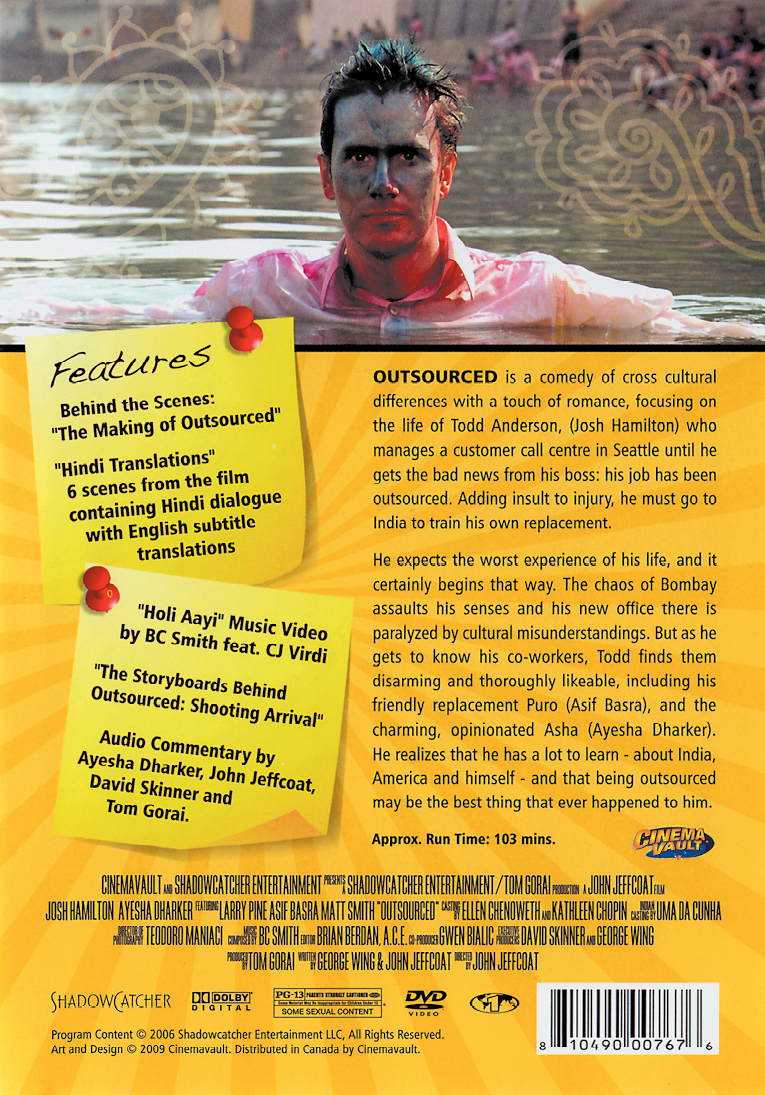
Outsourced is a modern-day comedy of cross-cultural conflict and romance. Todd Anderson (Josh Hamilton) spends his days managing a customer call center in Seattle until his job, along with those of the entire office, is outsourced to India. Adding insult to injury, Todd must travel to India to train his new replacement. As he navigates through the chaos of Bombay and an office paralyzed by constant cultural misunderstandings, Todd yearns to return to the comforts of home. But it is through his team of quirky yet likable Indian call center workers, including his friendly and motivated replacement, Puro (Asif Basra) and the charming, opinionated Asha (Ayesha Dharker) that Todd realizes that he too has a lot to learn – not only about India and America, but about himself. He soon discovers that being outsourced may be the best thing that ever happened to him.
OUTSOURCED. Direção de John Jeffcoat. 2006. (103 minutos), dêvedê, color.
b.


3.

c.
Listen to learn


Eyes on grammar – EXAMPLE 2
Movie scene – Parts um and dois
Title: Outsourced
Date: 2006
Source: DVD Outsourced
OUTSOURCED. Direção de John Jeffcoat. 2006. (103 minutos), dêvedê, color.
Clique no play e acompanhe a reprodução do Áudio.
Clique no play e acompanhe a reprodução do Áudio.
Constructing meanings


b.





Think a little more

-
- O que vocês acham da atitude do instrutor com relação à cultura de seus alunos?
- Na opinião de vocês, o problema de compreensão que acontece no diálogo foi causado por ignorância cultural ou por desrespeito a outras culturas? Justifiquem sua resposta.
- Comparem a situação apresentada com a história de Lillie (rídin). O que vocês acham da atitude de cada protagonista?
- Na opinião de vocês, o poder econômico e político de um país influencia a fórma como sua cultura é vista pelos outros? Justifiquem sua resposta.
lenguagi in équitchon
Faça no caderno as questões de resposta escrita.

1.
“Shall I open it right now?” I asked dramatically, trying to build suspense and excitement for the unveiling, as we do so often back in America.
“No!” said some of the students. “Yes!” said others. Hmm… that was odd.
“Am I supposed to open it in front of them?” I whispered desperately to Oliver, realizing I was entering a cultural confusion castle. (página 160)
Back in the guesthouse, I told the whole story to YCC’s Director, John, and he laughed heartily. (página 164)
a.
Versão adaptada acessível
Atividade 1, item a.
The words "asked", "said", "whispered" and "told" are used to refer to
c. saíd
Versão adaptada acessível
Atividade 1, item a.
In the excerpt “‘No!’ said some of the students. ‘Yes!’ said others.”, it is possible to replace the two ocurrences of the word "said" with
- discraibed .
- .

2.
asked (quatro vezes) explained replied said told (duas vezes )
a.
when I (um) espaço para resposta him if I could use the phone in the room, he (dois) espaço para resposta that there was a malfunction in the switchboard to be repaired, and he (três) espaço para resposta me in English “Telephone has gone KAPUTT” (the last term is neither English nor Italian). And then, when I (quatro) espaço para resposta him if he spoke Italian, he (cinco) espaço para resposta me “NO!”
ZINNI, Stefano. Travel stories. [s. l.]: Uccio, 2018. 448 páginaE-book.
b.
“I was a volunteer English teacher in a rural area of Vietnam when one day a couple of students (um) espaço para resposta me to “come dessert!” I hadn’t had ice cream in weeks, so I was keen. We boarded a very crowded bus Half an hour later, the horizon had changed entirely from tropics, to full blown sand dunes. We got off the bus, and I (dois) espaço para resposta my friend to explain again what we were doing. “Dessert” she (três) espaço para resposta, pointing to the mighty sand dunes. Oh dear! “It’s pronounced desert!” I (quatro) espaço para resposta, laughing. It was a great day though – we rode ostriches!”.
HOSTELWORLD Blog. Real travellers’ stories that will fill your soul with wanderlust. 2016. Disponível em: https://oeds.link/0XAgVf Acesso em: 30 abril 2022.

3.
“This is as if you took all my most precious dreams and put them in the form of a cloth,” I gushed, choking back tears of emotion. “It is the most perfect gift ever. Thank you so much!” I handed my camera to Oliver to take photos Again, I noted some strange expressions on the faces of everyone in the classroom. I began, with a sinking feeling, to realize that something, somewhere, had gone terribly wrong. 162)
“It will be all right,” said Oliver “In the end, it will help the children learn that different people do things in different ways around the world…” (página 162)
-
- .
- préposíchiâns.

4.
about in (quatro vezes) of (duas vezes ) to (três vezes) with

KENYA: A TRIP TO REMEMBER
reticências
One of my greatest travel experiences came during a study abroad trip (um) espaço para resposta Kenya. I traveled (II) espaço para resposta a group (três) espaço para resposta students (quatro) espaço para resposta Nairobi, Naramaru and Maasai Mara, (cinco) espaço para resposta Kenya. (seis) espaço para resposta all three places and the travel it took to get there, I had experiences that I would never have had (sete) espaço para resposta America. I was surrounded by people who spoke different languages, ate different food, dressed differently and valued different parts (oito) espaço para resposta life. For many (nove) espaço para resposta the group, it was a culture shock, but (dez) espaço para resposta me it was an amazing cultural immersion that I will remember for long into the future. Our professor and tour guide urged us to journal every day (onze) espaço para resposta our experiences, as I look back I can see where my eternal spark for travel was lit.
KENYA: a trip to remember.Disponível em: https://oeds.link/lUXsMo. Acesso em: 21 julho 2018.

5. áison grémer
Versão adaptada acessível
Atividade 5.
Read this other excerpt from the same written account used in question 4 and match the prepositions "about", "of", "on", "with" and "among" to what they express. If you have any doubts, check with the Eyes on grammar section.
“I wrote about my feelings of traveling alone in the city on public transportation, my time in the kitchen with our host family, teaching in the village school and the elephants I saw on safari, among other things.”
KENYA: a trip to remember. Disponível em: https://oeds.link/lUXsMo. Acesso em: 21 julho 2018.
e.
ráitin
Faça no caderno as questões de resposta escrita.
Hit the road
In pairs, you are going to produce a written account of a misunderstanding you were involved in or heard about. The misunderstanding may or may not have happened because of cultural differences. It is important that the story revolves around a misunderstanding of some kind. Remember you have already seen an example of a written account in Reading.
1.
For the written production
What is the discursive genre? Written account.
What is the theme? A misunderstanding.
What is the objective? To tell the story of a misunderstanding.
At whom is it aimed? The school community.
How and where is it going to be presented? It will be published in the school newspaper or displayed on the school board.
Who is going to participate? The whole class, organized into pairs.
Toolbox

-
- Façam um levantamento de algumas histórias envolvendo mal-entendidos que vocês consideram adequadas à tarefa. Vocês podem se valer das próprias lembranças, recorrer a familiares ou pesquisar na internet.
- Decidam que história vai ser relatada, considerando o que poderia ser mais interessante para os leitores.
- Organizem os fatos da história em ordem cronológica e usem palavras e expressões para sinalizar o encadeamento temporal dos eventos: fârst, den, áftâr, dét, lêirer, fáinali etcétera.
- Façam uma revisão dos tempos verbais adequados ao relato de uma história.
- Identifiquem nestas frases, retiradas do texto lido na seção rídin, os verbos utilizados para se referir a falas de personagens.
- “‘
- “‘
- “‘
- Pesquisem outros verbos em inglês que, como os identificados, costumam ser utilizados para expressar a fala de pessoas que participam de uma conversa; depois, decidam quais vocês vão usar no relato.
- Escrevam uma versão inicial do relato e troquem o texto com outra dupla para uma apreciação crítica e possíveis sugestões.
Step back

-
- conta a história de um mal-entendido;
- encadeia de fórma coerente os acontecimentos da história;
- sinaliza a sequência temporal com marcadores adequados;
- utiliza os verbos nos tempos apropriados a um relato;
- indica adequadamente a reprodução das falas de personagens, as quais aparecem entre aspas;
- emprega verbos como ésk, sêi, tél etcétera. para introduzir ou retomar as falas de personagens;
- apresenta linguagem, grafia e pontuação adequadas.

2.
piti istopi
Faça no caderno as questões de resposta escrita.

thinkirôver
Faça no caderno as questões de resposta escrita.

-
- O que você achou mais interessante nesta unidade?
- O que você aprendeu sobre diversidade cultural?
- Depois das discussões feitas ao longo da unidade, o que você pode falar sobre estereótipos e sobre maneiras de desconstruí-los?
- Como você fez para lidar com eventuais dificuldades de compreensão dos relatos escritos?
- Você ficou satisfeito com o relato escrito que produziu?
áison grémer
Read the examples extracted from this unit’s texts, as well as the highlighted words and expressions. Pay close attention to the notes that follow them.
egzâmpol uan
“‘We would like to present you with a gift,’ said Madam Yvonne breathlessly over the phone, ‘to say thank you for teaching in our school these past three months! Please stop by our school anytime today.’”
(página 160)
“‘Oh, no!’ I cried, ‘I’m so sorry. I was trying to read your face, but I thought you might be joking when you said ‘No’. Why didn’t you just grab my hands and stop me? In my culture, it is very rude NOT to open the present, so you should have showed me the right thing to do before I messed up!’
‘I didn’t want to embarrass you,’ said Oliver.
‘But I’m even more embarrassed now!’ I wailed. ‘You should have forcibly stopped me.’”
(página 162)
“‘Will you go to the seamstress to make it into another dress?’ John asked, trying to change the subject and soothe me.
‘WHAT?!’ I gasped, clapping my hands to my cheeks in horror. ‘Did you just call me FAT?’”
(página 164)
FREQUENTLY USED REPORTING VERBS / VERBOS DICENDI DE USO FREQUENTE
|
Bare infinitive / Infinitivo |
Past simple / Passado simples |
Bare infinitive / Infinitivo |
Past simple / Passado simples |
|---|---|---|---|
|
answer |
answered |
respond |
responded |
|
argue |
argued |
say |
said |
|
ask |
asked |
speak |
spoke |
|
cry |
cried |
suggest |
suggested |
|
gasp |
gasped |
tell |
told |
|
reply |
replied |
wail |
wailed |
|
request |
requested |
whisper |
whispered |
• Os ripórtin vârbs são usados para indicar a fala de alguém em uma narrativa.
Example 2
“‘We would like to present you with a gift,’ said Madam Yvonne breathlessly over the phone, ‘to say thank you for teaching in our school these past three months! Please stop by our school anytime today.’
Ah, but how could they NOT want to see the present and my face as I gazed upon it?”
(página 160 e 161)
“Again, I noted some strange expressions on the faces of everyone in the classroom.
In the end, it will help the children learn that different people do things in different ways around the world…”
(página 162)
“‘Will you go to the seamstress to make it into another dress?’ John asked, trying to change the subject and soothe me.”
164)
“You need to learn about India.”
167; Movie scene - Part umum)
|
PREPOSITIONS / PREPOSIÇÕES |
MEANINGS / SIGNIFICADOS |
|---|---|
|
about |
on the subject of |
|
around |
surrounding or on all sides of something |
|
in |
inside a place |
|
into |
changing from one form or condition to another |
|
of |
relationship between a part and a whole |
|
to |
showing motion in a direction |
|
upon |
on the surface of |
• Em outros contextos, as preposições podem ter sentidos diferentes.